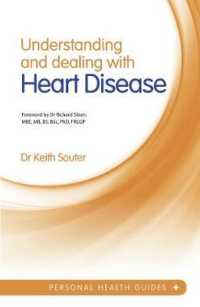Full Description
Mrs. Dalloway takes place on one day in the middle of June 1923. Its plot is seemingly thin: a middle-aged society hostess is having a party; she hopes the Prime Minister will attend; she reconnects with old friends from her youth. From these slimmest of premises a whole world unfolds. Of all of Virginia Woolf's novels, it is Mrs. Dalloway that appears to speak most intimately to our own time.
Selected contemporary reviews, both positive and negative, are included in the appendices of this edition, as are materials on the literary, political, medical, and educational contexts of the novel.
Contents
Acknowledgements
Introduction
Virginia Woolf: A Brief Chronology
A Note on the Text
Mrs. Dalloway
Appendix A: Contemporary Reviews
From John W. Crawford, "One Day in London the Subject of Mrs. Woolf's New Novel," The New YorkTimes Book Review (10 May 1925)
From Richard Hughes, "A Day in London Life," Saturday Review of Literature (16 May 1925)
From [Arthur Sydney McDowall,] "A Novelist's Experiment," Times Literary Supplement (21 May 1925)
From Gerald Bullett, "New Fiction," The Saturday Review (30 May 1925)
From "New Novels," New Statesman (6 June 1925)
From J.F. Holms, The Calendar of Modern Letters (July 1925)
From E.M. Forster, "The Novels of Virginia Woolf," The Criterion (April 1926)
From Edwin Muir, "Contemporary Writers: Virginia Woolf," Nation and Athenaeum (17 April 1926)
Appendix B: Literary Context
From Virginia Woolf, The Voyage Out (1915)
Virginia Woolf, "Mrs. Dalloway in Bond Street," The Dial (July 1923)
From Virginia Woolf, Mr. Bennett and Mrs. Brown (1924)
From Virginia Woolf, "Modern Fiction" (1925)
Appendix C: Political Context
From J. Ramsay MacDonald, War and the Workers: A Plea for Democratic Control (1915)
"German Women in London," The Times (13 May 1915)
From Sir Valentine Chirol, "India Old and New. I. Mr. Gandhi's Teaching," The Times (23 December 1920)
"Prime Minister's Appeal. 'Only Practicable Solution,' Call to Electors" The Times (5 December 1923)
List of British Prime Ministers from 1916 to 1937
Appendix D: Medical Context
From George H. Savage, "Moral Insanity" (July 1881)
From W.H.R. Rivers, "Psychiatry and the War" (18 April 1919)
From Henry Head, "An Address on the Diagnosis of Hysteria" (1922)
Appendix E: Educational and Social Context
From Cicely Hamilton and Lilian Baylis, The Old Vic (1926)
"Sir W. Anson on Workmen's Colleges," The Times (20 September 1905)
From the Sex Disqualification (Removal) Act (1919)
Works Cited and Select Bibliography








